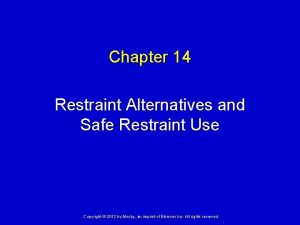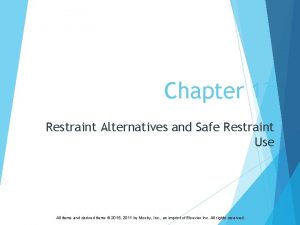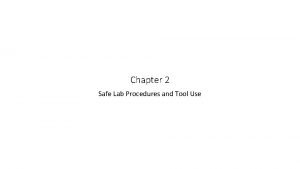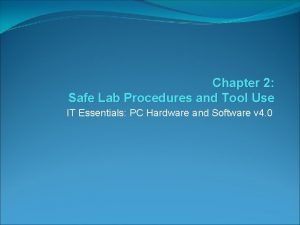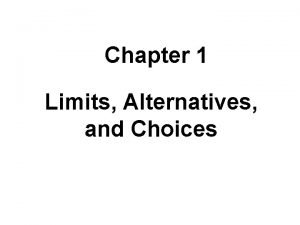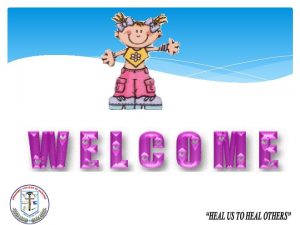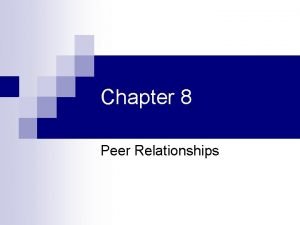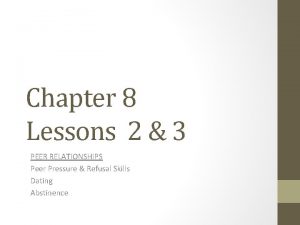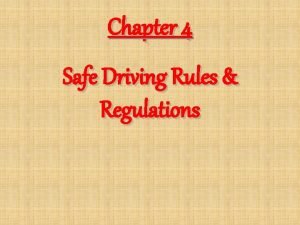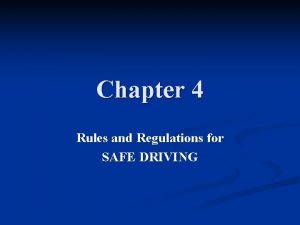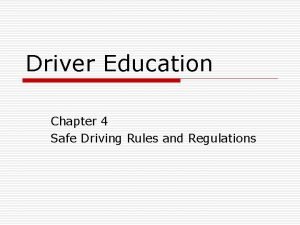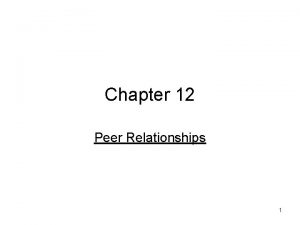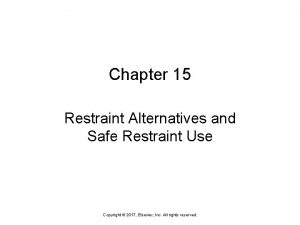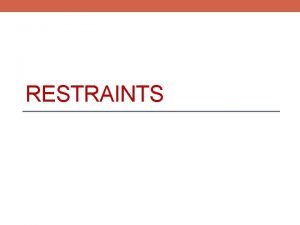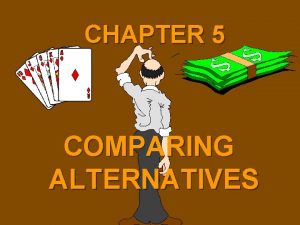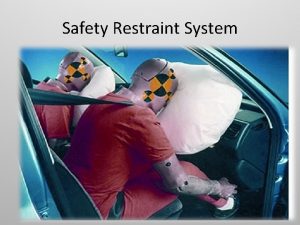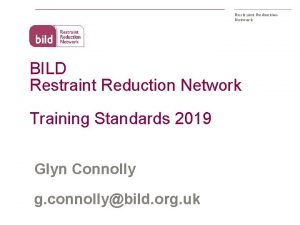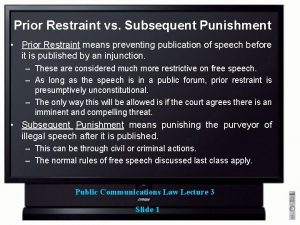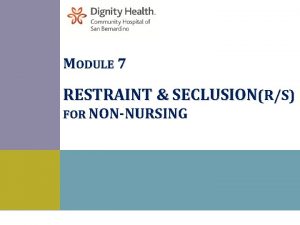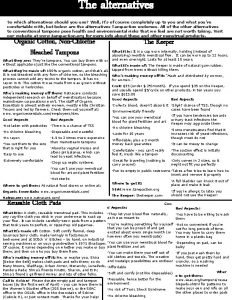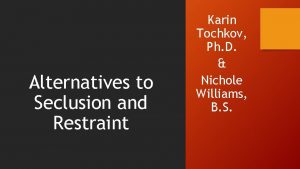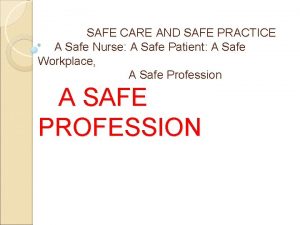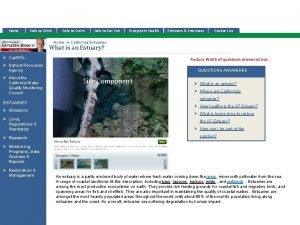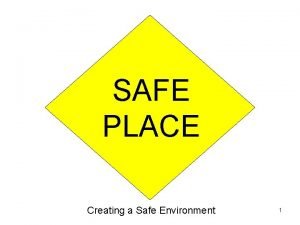Chapter 12 Restraint Alternatives and Safe Restraint Use


















- Slides: 18

Chapter 12 Restraint Alternatives and Safe Restraint Use All items and derived items © 2015, 2011 by Mosby, Inc. , an imprint of Elsevier Inc. All rights reserved.

Restraints Some persons need extra protection. Every attempt is made to protect the person without using restraints. Restraints are used only as a last resort to protect persons from harming themselves or others. All items and derived items © 2015, 2011 by Mosby, Inc. , an imprint of Elsevier Inc. All rights reserved. 2

Regulatory and Center Guidelines OBRA, the Centers for Medicare & Medicaid Services (CMS), the US Food and Drug Administration (FDA), The Joint Commission (TJC), state laws, and accrediting agencies have guidelines about restraint use. They do not forbid the use of restraints. They require trying all other appropriate alternatives first. Every center has policies and procedures about restraint use. All items and derived items © 2015, 2011 by Mosby, Inc. , an imprint of Elsevier Inc. All rights reserved. 3

Centers for Medicare and Medicaid Services (CMS) Terminology Physical restraint Chemical restraint Freedom of movement Remove easily CMS rules protect the person’s rights and safety. Restraints may only be used: To treat a medical symptoms or for the immediate physical safety of the person or others When less restrictive measures fail to protect the person or others Restraints must be discontinued at the earliest possible time. All items and derived items © 2015, 2011 by Mosby, Inc. , an imprint of Elsevier Inc. All rights reserved. 4

History of Restraint Use Until the late 1980 s, restraints were thought to prevent falls. Research shows that restraints cause falls. Injuries are more serious from falls in restrained persons. Older persons were restrained more often than were younger persons. Their purpose was to protect a person. They can cause serious harm, and even death. All items and derived items © 2015, 2011 by Mosby, Inc. , an imprint of Elsevier Inc. All rights reserved. 5

Restraint Alternatives Often there are causes and reasons for harmful behaviors. Knowing and treating the cause can prevent restraint use. Restraint alternatives for the person are identified. Restraint alternatives become part of the care plan. If restraint alternatives do not protect the person, the doctor may need to order restraints. All items and derived items © 2015, 2011 by Mosby, Inc. , an imprint of Elsevier Inc. All rights reserved. 6

Safe Restraint Use Restraints can cause serious injury and even death. Centers must follow: OBRA guidelines CMS guidelines FDA guidelines TJC guidelines State laws Restraints are not used to discipline a person or for staff convenience. All items and derived items © 2015, 2011 by Mosby, Inc. , an imprint of Elsevier Inc. All rights reserved. 7

Safe Restraint Use (Cont’d) According to OBRA, restraints are used only when necessary to treat a person’s medical symptoms. Sometimes restraints are needed to protect the person or others. Physical restraint: May be any manual method, physical or mechanical device, material, or equipment Is attached to or next to the person’s body Restricts freedom of movement or access to one’s body Cannot be easily removed by the person All items and derived items © 2015, 2011 by Mosby, Inc. , an imprint of Elsevier Inc. All rights reserved. 8

Chemical Restraints and Complications of Restraints Drugs are restraints if they: Control behavior or restrict movement Are not standard treatment for the person’s condition Complications of restraint use Injuries occur as the person tries to get free of the restraint. Injuries occur from using the wrong restraint, applying it wrong, or keeping it on too long. The most serious risk is death from strangulation. There also mental effects. All items and derived items © 2015, 2011 by Mosby, Inc. , an imprint of Elsevier Inc. All rights reserved. 9

Medical Devices Restraints are medical devices. The Safe Medical Device Act applies if a restraint causes illness, injury, or death. CMS requires the reporting of any death that occurs while a person is in restraints. Legal aspects Restraints must protect the person. A written doctor’s order is required. The least restrictive method is used. Restraints are used only after other measures fail to protect the person. Unnecessary restraint is false imprisonment. Informed consent is required. All items and derived items © 2015, 2011 by Mosby, Inc. , an imprint of Elsevier Inc. All rights reserved. 10

Restraint Application The least restrictive method is used. Some restraints attach to the person’s body and to a fixed (non-movable) object. Allows the greatest amount of movement or body access possible. Restricts freedom of movement or body access. Vest, jacket, ankle, wrist, hand, and some belt restraints are examples. Other restraints are near but not directly attached to the person’s body (bed rails or wedge cushions). Partially restrict freedom of movement. They allow access to certain body parts and are the least restrictive. All items and derived items © 2015, 2011 by Mosby, Inc. , an imprint of Elsevier Inc. All rights reserved. 11

Safety Measures for the Restrained Person Safety guidelines Observe for increased confusion and agitation. Protect the person’s quality of life. Follow the manufacturer’s instructions. Apply restraints with enough help to protect the person and staff from injury. Observe the person at least every 15 minutes or more often as required by the care plan. Remove the restraint, reposition the person, and meet basic needs at least every 2 hours. Follow the care plan. All items and derived items © 2015, 2011 by Mosby, Inc. , an imprint of Elsevier Inc. All rights reserved. 12

Recording Report and record: The type of restraint applied The body part or parts restrained The reason for the application Safety measures taken The time you applied the restraint The time you removed the restraint The person’s vital signs The care given when the restraint was removed Skin color and condition Condition of the limbs The pulse felt in the restrained part Changes in the person’s behavior Complaints of a tight restraint; difficulty breathing; and pain, numbness, or tingling in the restrained part (report these complaints to the nurse at once) All items and derived items © 2015, 2011 by Mosby, Inc. , an imprint of Elsevier Inc. All rights reserved. 13

Restraint Application Applying restraints Restraints are made of cloth or leather. Restraints may increase confusion and agitation in persons with dementia. Never use force to apply a restraint. Ask a co-worker to help apply the restraint if needed. Report problems to the nurse at once. Wrist restraints (limb holders) limit arm movement. Hands are placed in mitt restraints. Belt restraints are used when injuries from falls are risks or for positioning during a medical treatment. All items and derived items © 2015, 2011 by Mosby, Inc. , an imprint of Elsevier Inc. All rights reserved. 14

Types of Restraints Cloth restraints (soft restraints) Leather restraints Applied to the wrists and ankles. Wrist restraints Mitts, belts, straps, jackets, and vests. Applied to the wrists, ankles, hands, waist, and chest. Used when a person continually tries to pull out tubes used for life-saving treatment. (intravenous infusion [IV], feeding tube) Mitt restraints Prevent finger use. Allow hand, wrist, and arm movements. All items and derived items © 2015, 2011 by Mosby, Inc. , an imprint of Elsevier Inc. All rights reserved. 15

Types of Restraints (Cont’d) Belt restraints Prevent person from getting out of bed or out of a chair. A roll belt allows the person to turn from side to side or sit up in bed. The belt is applied around the waist and secured to the bed or chair (lap belt). It is applied over a garment. All items and derived items © 2015, 2011 by Mosby, Inc. , an imprint of Elsevier Inc. All rights reserved. 16

Types of Restraints (Cont’d) Vest restraints and jacket restraints are applied to the chest. A jacket restraint is applied with the opening in the back. For a vest restraint, the vest crosses in front. The straps of vest and jacket restraints: Always cross in the front Never cross in the back Are always applied over a garment Have life-threatening risks You are advised to only assist the nurse in applying vest and jacket restraints. Death can occur from strangulation. Never use force to apply a restraint. If a person is confused or agitated, ask a co-worker to help apply the restraint. Report problems at 2011 once. All itemsto andthe derivednurse items © 2015, by Mosby, Inc. , an imprint of Elsevier Inc. All rights reserved. 17

Quality of Life Restraints lessen the person’s dignity. The restrained person depends on others for basic needs. Try to understand the person’s situation to better understand how the person with restraints feels. Treat the person with kindness, caring, respect, and dignity. All items and derived items © 2015, 2011 by Mosby, Inc. , an imprint of Elsevier Inc. All rights reserved. 18
 Restraint alternatives
Restraint alternatives Restraint alternatives
Restraint alternatives Safe feed safe food
Safe feed safe food Safe people safe places
Safe people safe places Safe lab procedures
Safe lab procedures Safe lab procedures and tool use
Safe lab procedures and tool use Chapter 1 limits alternatives and choices
Chapter 1 limits alternatives and choices Unit 14 safe use of pesticides
Unit 14 safe use of pesticides Elbow restraints for pediatrics
Elbow restraints for pediatrics Chapter 8 healthy peer relationships
Chapter 8 healthy peer relationships Chapter 8 lesson 1 safe and healthy friendships
Chapter 8 lesson 1 safe and healthy friendships If a motorist's vehicle becomes disabled he/she must
If a motorist's vehicle becomes disabled he/she must Chapter 4 safe driving rules and regulations
Chapter 4 safe driving rules and regulations Chapter 4 safe driving rules and regulations
Chapter 4 safe driving rules and regulations Controlled uncontrolled and blind intersections
Controlled uncontrolled and blind intersections Chapter 8 lesson 1 safe and healthy friendships
Chapter 8 lesson 1 safe and healthy friendships Comparison and selection among alternatives
Comparison and selection among alternatives Ap psychology thinking language and intelligence
Ap psychology thinking language and intelligence Evaluating alternatives and making choices among them
Evaluating alternatives and making choices among them
